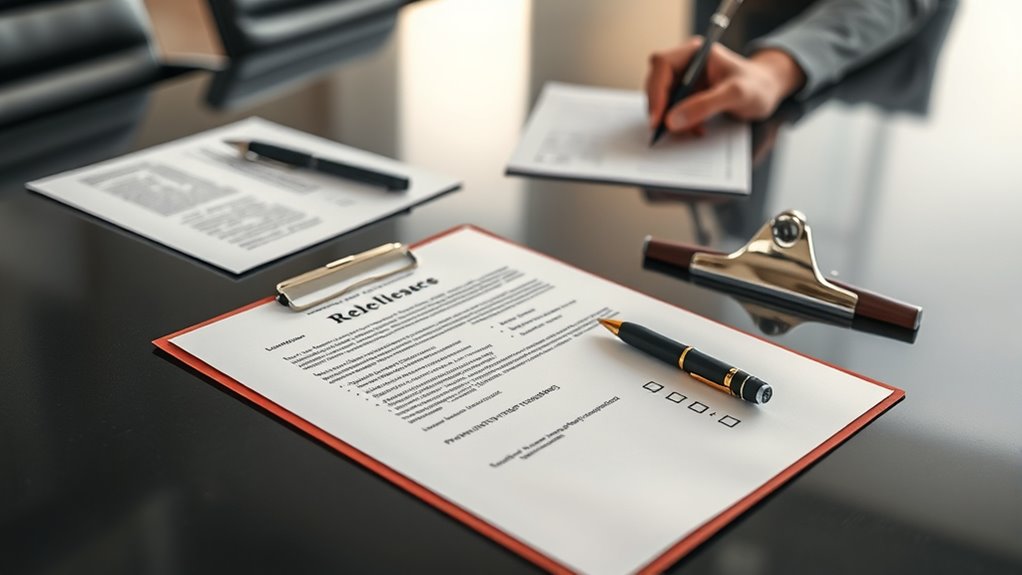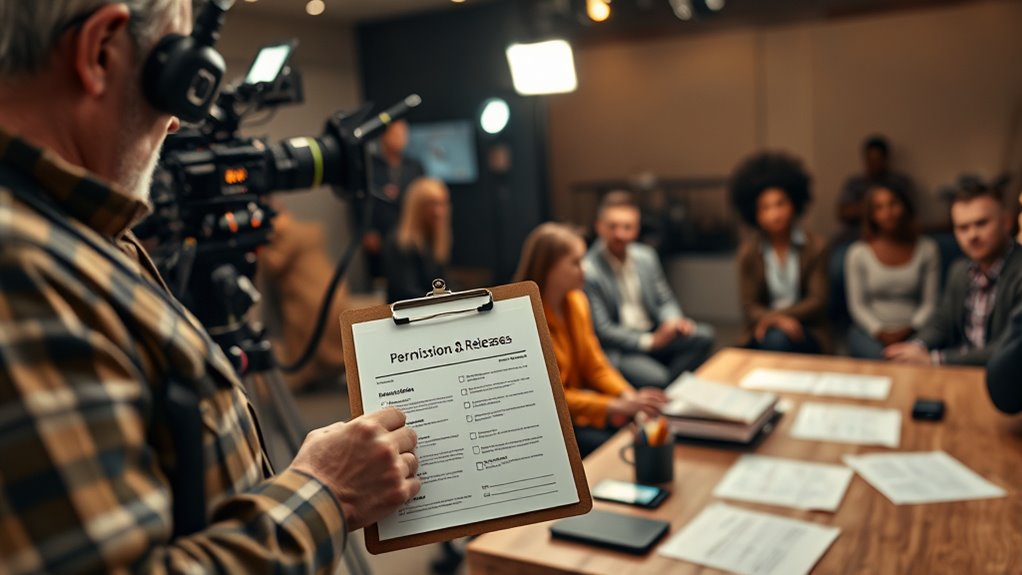When recording sets, it’s essential to get proper permissions for any copyrighted music you use and signed releases from everyone appearing on camera. This helps you avoid legal troubles like copyright infringement, fines, and privacy claims. Make sure you verify licensing requirements and obtain model releases in advance. Taking these proactive steps keeps your recordings compliant and protects your creators and participants—if you keep exploring, you’ll uncover even more ways to stay within the law.
Key Takeaways
- Obtain necessary licenses for copyrighted music used in recordings, such as synchronization and performance licenses.
- Secure signed model releases from individuals appearing in your set to protect privacy and publicity rights.
- Verify the licensing status of music (royalty-free, public domain, or licensed) before including it in your recording.
- Keep organized records of all signed releases and licensing agreements to demonstrate legal compliance.
- Consult legal or licensing professionals to ensure full adherence to copyright laws and privacy regulations.

If you’re planning to record sets, understanding the legal basics is vital to avoid potential issues. Before hitting record, you need to verify you have the proper permissions in place, especially when it comes to music licensing and model releases. These are foundational elements that protect you from legal disputes and help you stay compliant with copyright laws. Music licensing is particularly important if you’re using copyrighted songs, beats, or other musical works in your recordings. You can’t simply play or include music without securing the rights or licenses from rights holders. This typically involves obtaining synchronization licenses for music used in videos and performance licenses if you’re broadcasting or performing the music publicly. Failing to secure proper licensing can lead to hefty fines, takedown notices, or even lawsuits. To avoid this, you should research whether the music you plan to use is royalty-free, in the public domain, or if you need to negotiate a license. Some platforms offer licensing agreements that simplify this process, but always verify the scope of what’s covered. Additionally, understanding federal copyright laws can help you navigate the complex legal landscape surrounding recorded content.
Alongside music licensing, model releases are equally vital if your recording features people. A model release is a legal document that grants you permission to use someone’s likeness in your content. Without it, you risk facing claims of invasion of privacy or publicity rights violations. This is especially relevant if you’re capturing footage of individuals in private settings or recognizable in your videos. You should have each person sign a model release form before recording, clearly outlining how their image will be used, whether for commercial or promotional purposes. Keep these signed releases organized and accessible, as they serve as proof of consent if questions arise later. Remember that minors require a parent or guardian to sign on their behalf.
Both music licensing and model releases are about respecting intellectual property rights and personal privacy. Without these legal safeguards, you expose yourself to potential legal battles that can be costly and time-consuming. Making sure you have the appropriate licenses for music and signed releases from all participants will give you peace of mind and allow you to focus on creating your content. When in doubt, consult legal professionals or licensing experts to ensure your recordings are fully compliant with all relevant laws. Taking these steps upfront saves you from headaches down the line and helps maintain your reputation as a responsible creator.
Frequently Asked Questions
How Do I Handle Recording Permissions for Public Spaces?
When recording in public spaces, you need to follow public space regulations and obtain necessary permissions. Always check local rules, and if required, get consent from authorities or property owners. Use clear consent signage to inform people you’re recording. This helps make sure you’re compliant and respectful of privacy. If someone objects, be prepared to stop filming or adjust your plans to avoid legal issues or privacy violations.
What Are the Legal Differences Between Releases and Permissions?
Ever wondered how releases and permissions differ legally? Permissions give you the right to film in a location or with certain people, while releases are signed agreements that grant you rights to use the images or footage. Model distinctions matter because they determine legal implications—like whether you need consent from individuals or just authorization to access a space. Understanding these differences ensures you’re protected and compliant in your recording activities.
Do I Need Separate Releases for Minors Involved in the Shoot?
Yes, you need separate releases for minors involved in the shoot. Minor consent is required, and you must obtain parental authorization or a legal guardian’s signature for their participation. This guarantees you have legal permission from someone with authority over the minor. Without these releases, you risk legal complications or claims of unauthorized use. Always make sure the releases are signed by the parent or guardian before filming begins.
How Can I Verify Authenticity of Signed Release Forms?
To verify the authenticity of signed release forms, you should scrutinize signatures and check for consistency with known signatures, guaranteeing signature verification. Confirm the document’s authenticity by examining the signer’s details, date, and any notarization or witness signatures. Contact the signer directly if needed, and keep digital copies of the signed forms. These steps help prevent forgery, foster trust, and ensure your releases are legally legit and reliably valid.
What Are the Consequences of Recording Without Proper Permissions?
If you record without proper permissions, you face serious consequences like legal liabilities for unauthorized recordings. You could be sued for violating privacy rights, copyright laws, or contractual agreements, leading to fines or even criminal charges. Such actions damage your reputation and can halt production or distribution of your work. Always secure the necessary permissions and releases to avoid these risks, ensuring your recording process stays legally compliant and protected.
Conclusion
Understanding the legal basics for recording sets ensures you stay protected and respectful of others’ rights. Always seek permissions and secure releases before filming to avoid potential legal issues. Remember, taking these steps isn’t just about compliance—it’s about honoring the people and spaces you’re capturing. Isn’t it worth the effort to do things the right way and keep your project running smoothly? Stay informed, stay respectful, and record responsibly.










